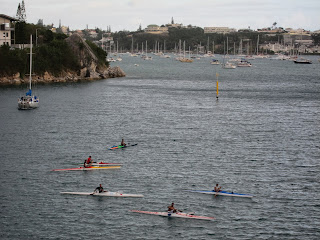 |
| Nouméa's beautiful harbor |
Our second stop in New Caledonia occurred the following day, and it was on the island of Grand Terre, in the capital city (and biggest city in the South Pacific): Nouméa. Nouméa is known as the “Paris of the Pacific” which may be a bit of a reach. Other than the fact that they speak almost exclusively French here, Nouméa does not resemble the unique look of Paris in any way; however, it was probably the most sophisticated place we have visited since Honolulu.
Unfortunately, our day started off with clouds and rain. Did we mention, it rains a-plenty here in these tropical Pacific Islands? Yes, a bright sunny day can fast turn into an unexpected gully washer, or vice versa. But a little rain would never stop the Supsics from doing an orientation tour around the city – especially since we were riding in a van!
 |
| Swaying palms along the beach of Baie des Citrons |
Our tour took us past two of the Grand Terre’s most beautiful beaches, Baie des Citrons and Anse Vata, where the palm trees were swaying gracefully in the balmy breeze.
 |
| Cannon at Ouen Toro |
 |
| St. Joseph's Cathedral and one of the many marinas |
New Caledonia is currently a French territory, but there is a push for independence being championed by the Kanaks (the indigenous people who represent about 40% of the population; the other 60% are French – sometimes known as “Caldoche”).
 |
| Rainy view of the islands near Nouméa |
Usually, we would sympathize with the native people, and the disparity between the Kanaks (often sporting dreadlocks or wearing colorful muumuu dresses) and the cosmopolitan French is painfully obvious even to daytrippers like us. We can certainly understand the Kanaks wanting their country back. However, comparing this lovely, well-ordered town with the chaos that is Port Vila in independent Vanuatu makes you wonder what the future will bring here.
 |
| Strange tuberous vegetables at the city market |
As we continued our walk, we bumped into an elderly French couple who were anxious to speak with us. We actually had a somewhat lengthy conversation which is remarkable since they spoke no English, only quick fire French! Somehow we managed to hold our own and were quite proud of ourselves. The woman was from Dijon in Burgundy (one of our favorite regions of France), so we had a lot of common ground to talk about. She even gave us the famous French double-kiss when we parted!
 |
| Listening to the English audio guide at the Musee de la Ville de Nouméa |
Our main goal for the day was to visit the Musee de la Ville de Nouméa (the city museum) to learn some local history. The museum was located in a charming colonial building that was once a bank. Basically, the island was claimed by France in 1853, but few French wanted to come here to live, so they turned it into a penal colony.
Society was very regimented with the local Kanaks on the bottom rung and the French at the top (except for the prisoners who were grouped according to the severity of their crimes). Apparently, the category into which you fell (almost like a caste system) came to be applied to all of your descendants. This limited self-advancement, like your ability to get a good education.
 |
| Photo of the "Kanak Exhibit" at the 1931 International Colonial Exposition in Paris |
This system provided an easy path for mistreatment of the local Kanaks; it proved to be similar to our own injustices toward the American Indian when America was in its infancy. The Kanak's land was stolen, and they were forced to live in designated areas where an 8:00 p.m. curfew was enforced. The French even took a group of Kanaks to the 1931 International Colonial Exposition in Paris where they were put on display like animals in a zoo.
 |
| WWII paraphernalia |
Of course, when the world wars came along, the “inferior” Kanaks were deemed good enough to die for the motherland. Unfortunately (but predictably), the citizenship promised to the Kanaks when they enlisted never happened for most of them.
During WWII, 10,000 American GIs were stationed in New Caledonia, and the islands were used as a staging ground for Guadalcanal, housing food supplies and munitions for the war effort.
During WWII, 10,000 American GIs were stationed in New Caledonia, and the islands were used as a staging ground for Guadalcanal, housing food supplies and munitions for the war effort.
 |
| Vanuatuan indentured laborers working nude at the nickel mines |
Nickel is a huge resource in New Caledonia – they have the 2nd largest source of nickel in the world (after Canada). Many immigrants from Vanuatu, Vietnam, China, and Japan came to work in the mines as indentured laborers under 5-year contracts. At the start of WWII, all the Japanese workers were sent to internment camps in Australia. Interestingly today, the majority of tourists are Japanese.
 |
| French chocolate shop in Nouméa |
We thoroughly enjoyed our history lesson and the French ambience of the city. We ate fabulous, crunchy baguette sandwiches for lunch and discovered a chocolate shop with delectable French dark chocolates.
 |
| In our stateroom, Frank looks pretty happy with his bootleg Manta beer! |
Frank also picked up a can of the local New Caledonia beer called Manta (which he was able to slip onboard the ship past the x-ray machine for an illicit guzzle in our stateroom). Our tour guide Phillipe had earlier recommended Manta as the best beer on the island, so we were out to put his words to the test.

No comments:
Post a Comment